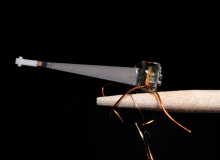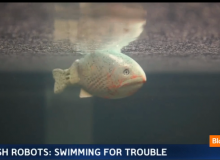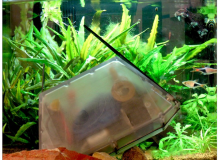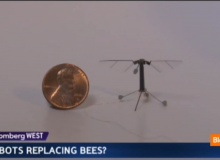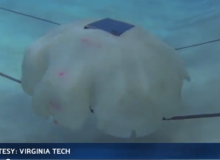Search
George Washington University
Friday, December 02, 2022
Robotic bees are being developed to study buzz pollination and help support the conservation of declining bee populations across the globe.
Tags: Biodiversity, Bees, ecology, animals, research, pollinators, nature, biotechnology
Planet Forward
Monday, October 25, 2010
They may not be sharks with frickin lazer beams attached to their heads, but they're about as close as you're going to get.
Tags: climate change, GW_Fall10, GWFall_10, elephant seals, antarctica, nahrwals, austin powers, dr. evil
Wednesday, May 23, 2012
Researchers from University of Michigan are looking to fish to monitor water quality. But, we're not talking about Nemo, these fish are robots!
Tags: Robots, robotic fish, fish robots, sensor networks, biomimicry
Tuesday, June 05, 2012
Our latest on Bloomberg West focuses on innovations from Michigan State University to better monitor the world's waterways.
Tags: water quality, michigan state university
National Science Foundation
Monday, September 26, 2011
The University of Minnesota's Center for Distributed Robotics is developing an amphibious robotic system, the Aquapod, to monitor the impact of oil on swamps and marshland.
Tags: Technology, National Science Foundation, Science Corner, oil spills
Tuesday, April 16, 2013
Some really cool robots are underwater! Shashank Priya, associate professor in mechanical engineering in the College of Engineering at Virginia Tech, explains the small robot jellyfish, Robojelly.
Planet Forward, George Washington University School of Media and Public Affairs
Tuesday, July 02, 2013
Faced with the specter of declining bee populations, scientists at Harvard are working on a mechanical replacement - and they may just revolutionize robotics along the way.
Tags: Bees, robobee, colony collapse, pollination, colony collapse disorder, ccd, honeybee, bee colony, queen bee
Friday, June 01, 2012
Don't Mock Me...Unless It's Eco-Friendly!
Wednesday, May 16, 2012
Electrotrak is a network of extruded tracks that would be installed initially on the left side of HOV lanes.
Tags: electric vehicle charging on the fly
Monday, April 29, 2013
This week, Planet Forward looks into Robojelly, a fascinating and sustainable ocean research innovation, designed by Dr. Shashank Priya and his research team at Virginia Tech.

